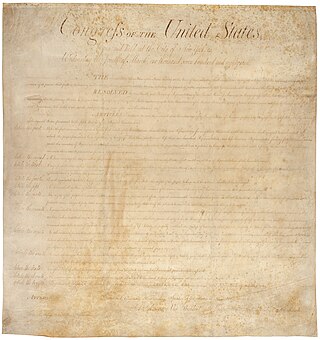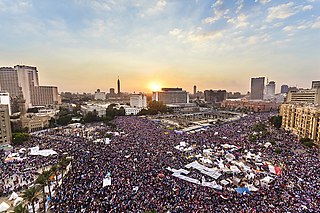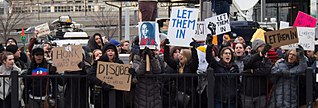In legal terminology, a complaint is any formal legal document that sets out the facts and legal reasons that the filing party or parties believes are sufficient to support a claim against the party or parties against whom the claim is brought that entitles the plaintiff(s) to a remedy. For example, the Federal Rules of Civil Procedure (FRCP) that govern civil litigation in United States courts provide that a civil action is commenced with the filing or service of a pleading called a complaint. Civil court rules in states that have incorporated the Federal Rules of Civil Procedure use the same term for the same pleading.
Vexatious litigation is legal action which is brought solely to harass or subdue an adversary. It may take the form of a primary frivolous lawsuit or may be the repetitive, burdensome, and unwarranted filing of meritless motions in a matter which is otherwise a meritorious cause of action. Filing vexatious litigation is considered an abuse of the judicial process and may result in sanctions against the offender.
A chain letter is a message that attempts to convince the recipient to make a number of copies and pass them on to a certain number of recipients. The "chain" is an exponentially growing pyramid that cannot be sustained indefinitely.

A pyramid scheme is a business model which earns primarily by enrolling others into the scheme, however rather than earning income by sale of legitimate products to an end consumer, it mainly earns by recruiting new members with the promise of payments. As recruiting multiplies, the process quickly becomes increasingly difficult until it is impossible, and most members are unable to profit; as such, pyramid schemes are unsustainable and often illegal.
In law, a summary judgment, also referred to as judgment as a matter of law or summary disposition, is a judgment entered by a court for one party and against another party summarily, i.e., without a full trial. Summary judgments may be issued on the merits of an entire case, or on discrete issues in that case. The formulation of the summary judgment standard is stated in somewhat different ways by courts in different jurisdictions. In the United States, the presiding judge generally must find there is "no genuine dispute as to any material fact and the movant is entitled to judgment as a matter of law." In England and Wales, the court rules for a party without a full trial when "the claim, defence or issue has no real prospect of success and there is no other compelling reason why the case or issue should be disposed of at a trial."
Edward Davis (Ed) Fagan is a former American reparations lawyer who was disbarred for his conduct involving dishonesty, fraud, deceit, or misrepresentation.

The Federal Reporter is a case law reporter in the United States that is published by West Publishing and a part of the National Reporter System. It begins with cases decided in 1880; pre-1880 cases were later retroactively compiled by West Publishing into a separate reporter, Federal Cases. The fourth and current Federal Reporter series publishes decisions of the United States courts of appeals and the United States Court of Federal Claims; prior series had varying scopes that covered decisions of other federal courts as well. Though the Federal Reporter is an unofficial reporter and West is a private company that does not have a legal monopoly over the court opinions it publishes, it has so dominated the industry in the United States that legal professionals, including judges, uniformly cite to the Federal Reporter for included decisions. Approximately 30 new volumes are published each year.

Tort reform consists of changes in the civil justice system in common law countries that aim to reduce the ability of plaintiffs to bring tort litigation or to reduce damages they can receive. Such changes are generally justified under the grounds that litigation is an inefficient means to compensate plaintiffs; that tort law permits frivolous or otherwise undesirable litigation to crowd the court system; or that the fear of litigation can serve to curtail innovation, raise the cost of consumer goods or insurance premiums for suppliers of services, and increase legal costs for businesses. Tort reform has primarily been prominent in common law jurisdictions, where criticism of judge-made rules regarding tort actions manifests in calls for statutory reform by the legislature.

In the United States, the right to petition is enumerated in the First Amendment to the United States Constitution, which specifically prohibits Congress from abridging "the right of the people peaceably to assemble, and to petition the Government for a redress of grievances".
The Story of 1 is a BBC documentary about the history of numbers, and in particular, the number 1. It was presented by former Monty Python member Terry Jones. It was released in 2005.
Donald Marsh Middlebrooks is a United States district judge of the United States District Court for the Southern District of Florida.
The Indian Claims Commission (ICC) was a judicial relations arbiter between the United States federal government and Native American tribes. It was established under the Indian Claims Act of 1946 by the United States Congress to hear any longstanding claims of Indian tribes against the United States. It took until the late 1970s to complete most of them, with the last case finished in the early 21st century.
The Oregon State Bar (OSB) is a public corporation and instrumentality of the Oregon Judicial Department in the U.S. state of Oregon. Founded in 1890 as the private Oregon Bar Association, it became a public entity in 1935 that regulates the legal profession. The public corporation is part of the Oregon Judicial Department.

The Guantanamo Bay Hunger Strikes were a series of prisoner protests at the U.S. detention camp Guantanamo Bay in Cuba. The first hunger strikes began in 2002 when the camp first opened, but the secrecy of the camp's operations prevented news of those strikes from reaching the public. The first widely reported hunger strikes occurred in 2005.

Alekseyev v. Russia is a case before the European Court of Human Rights concerning the prohibition of the 2006, 2007 and 2008 Moscow Pride gay rights marches in Russia's capital. The case was brought by Russian LGBT activist Nikolay Alexeyev, organiser of the marches, who claimed the banning of the marches had violated Article 11 of the European Convention on Human Rights. He claimed furthermore that he had not received an effective remedy under Article 13 against the violation of Article 11, and that he had been discriminated against by the authorities in Moscow under Article 14 in their consideration of his applications to hold the marches.

The 30 June revolution occurred in Egypt on 30 June 2013, marking the one-year anniversary of Mohamed Morsi's inauguration as president. The events ended with the 2013 Egyptian coup d'état after mass protests across Egypt demanding the immediate resignation of the president. The rallies were partly a response to Tamarod, an ostensibly grassroots movement that launched a petition in April 2013, calling for Morsi and his government to step down. Tamarod claimed to have collected more than 22 million signatures for their petition by June 30, although this figure was not verified by independent sources. A counter-campaign in support of Morsi's presidency, named Tagarod, claimed to have collected 26 million signatures by the same date, but this figure was also unverified and not mentioned in media nearly as much as Tamarod's, with no reliable sources repeating it. The movements in opposition to Morsi culminated in the June 30 protests that occurred across the country. According to the Egyptian military, which calculated the number of protesters via helicopter scans of demonstration perimeters across the country, the June 30 protests had 32 million protesters, making them "the biggest protests in Egypt's history." However, independent observers raised concerns that the Egyptian government exaggerated the actual number of anti-Morsi protestors, with some research determining that only around one to two million people protested across the country against Morsi.

Telexfree, a trade name owned by Telexfree Inc., was a multibillion-dollar Ponzi scheme disguised as an internet phone service company. Prosecutors have described it as the largest fraud of all time in terms of the number of people affected - more than 1 million, with victims in various countries. The brand became best known for its operations in Brazil held by Ympactus Comercial Ltda after it was involved in an ongoing investigation and trial for operating a Ponzi scheme, and later for having its operations suspended in the US by SEC under the charges of operating a multibillion-dollar Ponzi and pyramid scheme.

In re Garlock Sealing Technologies, LLC is a court case heard in the United States District Court for the Western District of North Carolina which involves the entry into bankruptcy proceedings by Garlock Sealing Technologies, once a manufacturer of coated asbestos gaskets, as a result of potential liability from current and future settlements. The plaintiffs were over 4,000 asbestos victims suffering from mesothelioma, including many Navy veterans, as well as an unknown number of future mesothelioma victims. As noted by the court, mesothelioma "is always fatal, causing death essentially by suffocation within about eighteen months of diagnosis" and involves "a horrific death."

Slavery in ancient Egypt existed at least since the Old Kingdom period. Discussions of slavery in Pharaonic Egypt are complicated by terminology used by the Egyptians to refer to different classes of servitude over the course of dynastic history. Interpretation of the textual evidence of classes of slaves in ancient Egypt has been difficult to differentiate by word usage alone. There were three types of enslavement in Ancient Egypt: chattel slavery, bonded labor, and forced labor. Even these seemingly well-differentiated types of slavery are susceptible to individual interpretation. Egypt's labor culture encompassed many people of various social ranks.

In late January and early February 2017, during protests against Executive Order 13769, commonly referred to as the “Muslim ban,” thousands of people gathered at various airports in the United States and around the world to protest the Trump administration’s attempt to prevent the returning of refugees and other visitors from seven countries considered by the administration to be unsafe. According to various sources, more than two thousand people were at the protest at John F. Kennedy International Airport in Queens, New York City with other protests appearing at significant international airports and other important sites around the United States. Protests continued daily and internationally through February 6. Protests also continued after a federal judge issued a temporary restraining order against parts of the travel ban.










